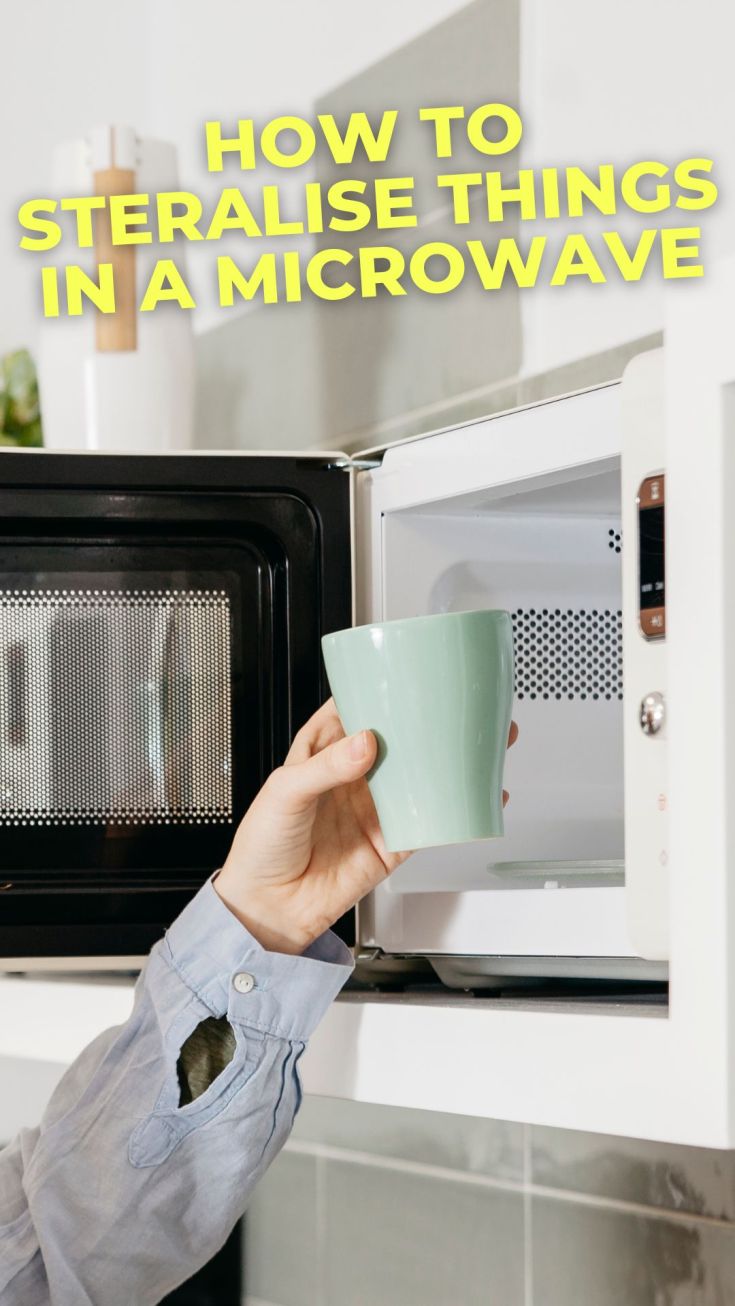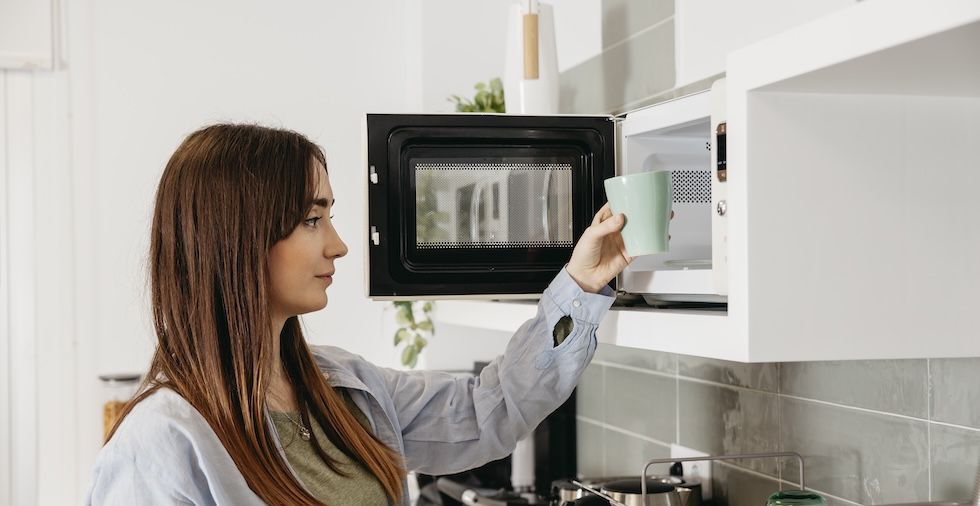- Can you sterilise things in the microwave?
- Sterilising in a microwave: 4 different strategies to try
Sterilising in a microwave is often a simple solution. Whether you are dealing with baby bottles, jars, or other objects, you need to make sure that you get it right. Of course, there is a fine art to keeping your things as clean as possible.
For example, new baby bottles need to be sterilised to get rid of any potentially dangerous germs before being used, but after that, there's no need to sterilise them again. It is enough to give them a good scrub in a dishwasher or with hot water and soap. Although sterilisation provides additional benefits in terms of killing germs, it is usually not necessary for healthy children with access to clean water and strong immune systems.
Today, we'll explore the four different approaches to sterilising jars, bottles, and feeding objects in the microwave. Here's what you need to know.
Can you sterilise things in the microwave?
The short answer is yes—yes, you can! If you want to keep things safe, using a microwave oven could be the answer. Research published in the National Library of Medicine found that sterilising in a microwave can kill fungi, viruses, and aerobic and anaerobic bacteria. The study suggested that you can achieve 'consistent sterilisation' by rotating the item.
Of course, as you may already know, most microwave ovens do this anyway. Your microwave will likely have a plate in the middle of its compartment that rotates when it is on. Therefore, you don't have to worry about taking the item out and turning it when sterilising in a microwave. The oven does all the hard work for you in this simple process.
Sterilising in a microwave: 4 different strategies to try
Approach 1: Steam sterilising bags
Using a microwave to sterilise tiny objects like infant bottles, breast pump parts, or other items is easier and more effective with the help of steam sterilising bags. These bags are made specifically to make a steam environment that can kill germs and other dangerous microbes.
Put the objects in the bag: Before using a steam sterilising bag, start by putting the objects you want to disinfect in the bag. Read the instructions, which usually involve filling the bag with a tiny amount of water and then tightly sealing it. The water is necessary to create steam when the bag is heated in the microwave.
Follow the directions on the bag: When the bag is ready, with water and objects inside, follow the directions to microwave it. To guarantee complete sterilisation, the bag usually needs to be microwaved for a few minutes at a high power.
Be careful with the steam: After microwaving, take the bag out of the microwave carefully, ensuring to follow any chilling guidelines that may be included. Because the contents will be hot and steam may escape, handle the bag carefully when opening it, and let the products cool completely before holding them.
Steam steriliser bags, from well-known brands like Tommee Tippee and MAM, are ideal for parents and caregivers on the go who want a quick and efficient way to sterilise items. So, the next time you're asking for a portable option for how to sterilise a mam bottle in a microwave, these bags will come in especially handy.
Approach 2: Self-sterilising bottles
Certain baby bottles, like those from MAM or Tommee Tippee, have self-sterilising features. These bottles have a unique base that can be filled with water and microwaved to encourage steam sterilisation, showing how to sterilise a bottle in the microwave.
Take the bottle apart: Start by taking it apart into separate sections, including the collar, nipple, and any other elements that can be removed. Put these parts inside the bottle's microwave-safe base. Next, carefully add the necessary amount of water to the base by following the instructions.
Place in the microwave: After all the parts are in place and the base is filled with water, put the constructed bottle in the microwave. The bottle should be left in the microwave for a few minutes. The heat from the microwave will create steam from the water in the base, which will sterilise the bottle and all of its parts.
Take care when removing: After microwaving, be cautious when handling the sterilised bottle and components, as they may be hot. Allow them to cool down completely before using them for feeding.
Approach 3: Using a Microwave Steriliser
Put the objects inside the steriliser: Place the objects you need to sterilise inside the steriliser and then fill the base with the necessary amount of water. Different amounts of water may be required depending on the particular steriliser type, so it's important to follow the instructions that come with the steriliser.
Shut the lid firmly: After everything is put in the correct place and water is added to the base, shut the steriliser's lid firmly to create a sealed environment. The lid is necessary for the steriliser to maintain steam throughout the sterilisation process.
Follow the directions: Now, insert the steriliser into the microwave and follow the manufacturer's directions to set the time and power level. Microwave sterilisers usually just need to be heated at high power for a few minutes to produce enough steam to disinfect an object. Let the steriliser cool down after using a microwave before opening it.
Approach 4: DIY Steam sterilisation
When considering how to sterilise jars in a microwave, the first step is to ensure that the jars or other heat-resistant materials are well-cleaned.
Use a microwave-safe container: Place the cleaned jars into a lidded, microwave-safe container. Select a container that can hold the stuff in it without being too crowded. Fill the container's bottom with a tiny bit of water. To keep the steam within the container during heating, ensure the lid is secured firmly.
Microwave on high: Now, microwave the container for a few minutes on high power. The number of things being sterilised and the microwave's wattage will determine the precise time. The objective is to heat the water to a temperature that will produce steam and sterilise the jars.
Allow some cooling time: After microwaving, let the container cool down before handling the sterilised objects. Don't open the container too quickly, as this might release hot steam and cause burns.
Jars used for food preservation or canning benefit greatly from the steam sterilisation process. It's a convenient and adaptable alternative for home use, depending on the size and amount of goods you need to sterilise.
Sterilising objects in a microwave can be a practical and efficient solution for people who lead hectic lives, particularly for parents of young children. To guarantee correct sterilisation and avoid harm to items or the microwave oven itself, you must follow manufacturer instructions and safety standards.
Companies like Tommee Tippee, MAM, and Vital Baby provide innovative solutions to make microwave sterilisation practical and affordable for daily use. These techniques allow you to easily and worry-free sterilise a variety of objects in your microwave.
Q&A
Will microwaving something kill germs?
Yes! As we have covered in this guide, you can sterilise in a microwave. That is because a microwave has the power to kill germs. Studies have shown that the microwave oven can kill germs, bacteria, and fungi. Be sure to follow the instructions we have shared.
Does microwaving pasta kill bacteria?
If you are worried about bacteria in your food, using a microwave could be the answer. When reheating food, you should make sure that it is cooked thoroughly and internally. Therefore, you should always follow proper food safety instructions when reheating various types of food. Check out the food reheating guidelines here.
Does boiling water kill bacteria?
Boiling water can inactivate bacteria and viruses. However, simply boiling water is not the same as sterilising something. If you are worried about bacteria, you must use a proper sterilisation process. That way, you can protect yourself and your loved ones when using things.
Does bleach kill bacteria?
Bleach can help you disinfect things. It contains sodium hypochlorite, which can kill bacteria, fungi, and viruses. However, you should not rely entirely on using bleach to sanitise stuff in your home. Make sure that you read up about the various ways to keep things sanitary. That way, you can make sure that you are taking the proper steps to prevent any bacteria or germs.
Which of these approaches will you be trying? Let us know in the comments below!


Leave a Reply